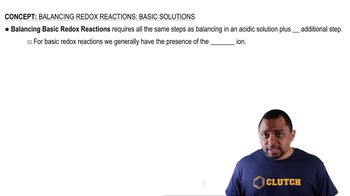Textbook Question
Balance the half-reactions in Problem 19.43, assuming that they occur in basic solution.
 Verified step by step guidance
Verified step by step guidance



Balance the half-reactions in Problem 19.43, assuming that they occur in basic solution.
Write unbalanced oxidation and reduction half-reactions for the following processes. . (a) Te(s) + NO3-(aq) → TeO2(s) + NO(g)
Write unbalanced oxidation and reduction half-reactions for the following processes. . (b) H2O2(aq) + Fe2+(aq) → Fe3+(aq) + H2O(l)
Write unbalanced oxidation and reduction half-reactions for the following processes. (b) Mn3+(aq) → MnO2(s) + Mn2+(aq)
Balance the following half-reactions. (a) (acidic) Cr2O72-(aq) → Cr3+(aq)
Balance the following half-reactions. (b) (basic) CrO42-(aq) → Cr(OH)4-(aq)